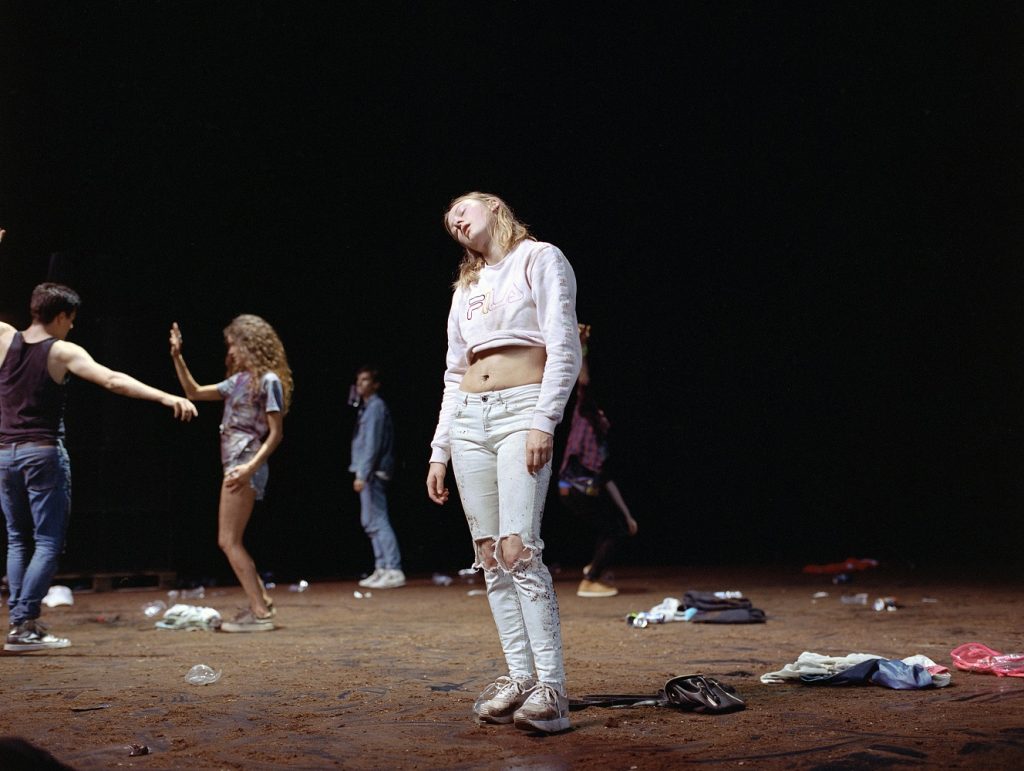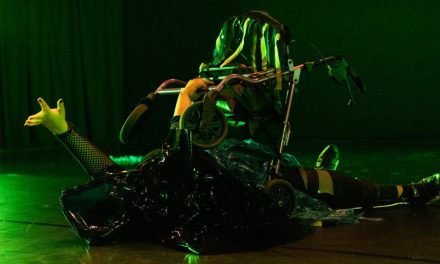This past Thursday evening, LA Dance Project presented CROWD, a partnership with Dance Reflections by Van Cleef and Arpels, outside of their residence near downtown LA. With stunning choreography by Gisèle Vienne, the audience was taken through an experiential journey in this site specific work that took place in a parking lot amongst the industrial backdrop of urban Los Angeles at night. After a beautiful performance of Benjamin Millipied’s Be Here Now, performed by company members of LA Dance Project, the audience was moved to rows of brightly lit bleachers in the back lot of the theater’s building. The blank asphalt stage had recently been washed down with water, already reflecting the bright production lights above and setting the city scene for something fantastical.
We see a young woman in a hooded sweatshirt, gold lame top, and sequined sneakers slowly walk from one end of the lot (stage right) towards the other (stage left). But she’s not just walking slow, she’s walking in slow motion. It is almost as if the audience were watching a film slowed down to nearly half the speed. There is an unexplainable emotion that comes with this simple and defiant act. She is not just imitating a slow motion walk; she becomes a slow motion walker; a character defined by this activity. As she walks across the concrete fixated on a destination, the mind begins to play tricks as thirteen more performers enter the scene all exhibiting the same slow movement. I started to wonder if they were in fact moving at the pace I was watching. Or if I am just seeing it that way. This incredible conception by Vienne made me feel as though I were watching reality through a dream space.
Two cars, headlights on, drive up stage right, as eight movers open their doors and arrive on the scene. Everyone quickly becomes a very identifiable character as some are dressed in jeans and boots, others in sweatshirts, wind jackets, and hats. Some movers walk from the direction of the cars on their own, smoking, laughing, straggling behind. The scene becomes a familiar party we have all been too. The gathering has a fun and maybe dirty or naughty atmosphere to it; maybe something you are, or perhaps are not, supposed to be doing as a young adult and that was a thrilling feeling to return to. Each mover begins to make relations with the others; holding hands, waving, excitement on their faces as they motion for a hug, and the best part? It is all incredibly slow, making it very easy to figure out who knows who, who is there with intention, motives, friendships, enemies, and the whole location becomes one big, complicated party. Movers Massimo Fusco, Vincent Dupuy, Henrietta Wallberg, Oskar Landström, Philip Berlin, Sophie Demeyer, Katia Petrowick, Marine Chesnais, Sylvain Decloitre, Jonathan Schatz, Rehin Hollant, Maya Masse, Lucas Bassereau, and Linn Ragnarsson made me feel as though my reactions to others in the audience, and attentiveness to the party was completely genuine.
Amongst the alluring complications of this outdoor soiree, it is hard to not mention the importance of the brilliant music. With editing/mixing and playlist selection by Peter Rehberg, and sound diffusion supervisor Stephen O’Malley, Rehberg chose tracks from several different historically significant electronic dance music records. Vienne quotes, “[we used] works by musicians that are significant for the Detroit scene, among others, with Jeff Mills and other people from Underground Resistance, plus Manuel Göttsching, for example. The aim was to create a mix that covers an entire range of essential sounds that has been exciting for us over the last forty years. Besides these tracks, which are used over the greater part of the production, there’s also an original piece composed by KTL (Stephen O’Malley and Peter Rehberg) and another by Peter Rehberg on his own.” The music, combined with Vienne in collaboration with the performers’ movement, emitted a feeling of underground dance party-get sweaty-dance your heart out-forget your troubles-vibe. It was a space where I could become a part of the party, where I was stylizing my own way of communicating with each character and reacting to the vibrations. The movers did eventually break their deliberate decelerated movement in correlation with the beats of the techno music playing. As a collective, they would move in real time on beats of three or four, before returning to slow, for an eight count or two, and grooving right back in with the real time beats.
After an hour or so of dreamlike movement, which dominated the entirety of the production, I began to crave the normalcy of longer moments of movement in accelerated real time. There is an uncomfortable anxiety that follows with the craving and seeking of human behavior in actuality. This difficulty in sitting with comfortability is where Vienne’s choreographic rhythm truly shines. It brought me right back to those late night parties, as bottles break, and food flies, and you are under some exhilarating influence, trying to make out what is real, what is not, and to whom you are even talking. I was able to zoom in and zoom out of conversations, social interactions, and blurred decision making like I was actually there amongst the performers. Vienne gave each of us the opportunity to dissect and select not only what we wanted to see but how we wanted to see them. The performers gave us scenarios to enjoy and laugh at, but also to hate and detest. The great treasure of CROWD was the space and time to insert what you needed from that party you missed out on, that party you did not go to, that party you even loved. You could re-course your own history, redress the performance in what you personally needed. CROWD is exactly what the LA dance scene needs, and I would not miss Gisèle Vienne’s next party for anything.
#####
To learn more about Gisèle Vienne, please visit her website.
To learn more about Dance Reflections, please visit their website.
To learn more about LA Dance Project, please visit their website.
Written by Grace Courvoisier for LA Dance Chronicle.
Featured image: CROWD by Gisèle Vienne – Photo © Mathilde Darel









